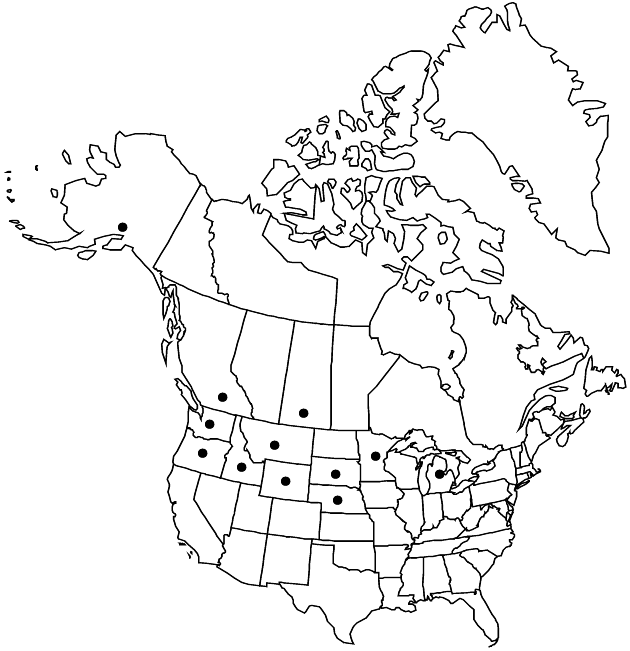Difference between revisions of "Logfia arvensis"
Notes Roy. Bot. Gard. Edinburgh 33: 432. 1975.
FNA>Volume Importer |
imported>Volume Importer |
||
| (2 intermediate revisions by 2 users not shown) | |||
| Line 8: | Line 8: | ||
}} | }} | ||
|common_names=Field cottonrose;cotonnière des champs | |common_names=Field cottonrose;cotonnière des champs | ||
| + | |special_status={{Treatment/ID/Special_status | ||
| + | |code=W | ||
| + | |label=Weedy | ||
| + | }}{{Treatment/ID/Special_status | ||
| + | |code=I | ||
| + | |label=Introduced | ||
| + | }} | ||
|basionyms={{Treatment/ID/Basionym | |basionyms={{Treatment/ID/Basionym | ||
|name=Filago arvensis | |name=Filago arvensis | ||
| Line 34: | Line 41: | ||
|elevation=100–1700 m | |elevation=100–1700 m | ||
|distribution=B.C.;Sask.;Alaska;Idaho;Mich.;Minn.;Mont.;Nebr.;Oreg.;S.Dak.;Wash.;Wyo.;Eurasia;nw Africa. | |distribution=B.C.;Sask.;Alaska;Idaho;Mich.;Minn.;Mont.;Nebr.;Oreg.;S.Dak.;Wash.;Wyo.;Eurasia;nw Africa. | ||
| + | |introduced=true | ||
|discussion=<p><i>Logfia arvensis</i> appears to be basal or nearly so in <i>Logfia</i> and Filagininae (J. D. Morefield 1992); only 2–4 epappose florets are present in most heads. Reports of <i>L. arvensis</i> from Ontario and New York have not been confirmed by me. A report from the Desert National Wildlife Range in southern <i>Nevada</i> (T. L. Ackerman et al. 2003) was likely based on specimens of <i>L. filaginoides</i>. The earliest specimen confirmed from the flora area was from Bonner County, Idaho, in 1934. The label on one nineteenth-century specimen (mixed with <i>Diaperia verna</i>) identifying it as coming from Dallas, Texas, is probably in error; no other collections of <i>L. arvensis</i> are known from in or near Texas.</p> | |discussion=<p><i>Logfia arvensis</i> appears to be basal or nearly so in <i>Logfia</i> and Filagininae (J. D. Morefield 1992); only 2–4 epappose florets are present in most heads. Reports of <i>L. arvensis</i> from Ontario and New York have not been confirmed by me. A report from the Desert National Wildlife Range in southern <i>Nevada</i> (T. L. Ackerman et al. 2003) was likely based on specimens of <i>L. filaginoides</i>. The earliest specimen confirmed from the flora area was from Bonner County, Idaho, in 1934. The label on one nineteenth-century specimen (mixed with <i>Diaperia verna</i>) identifying it as coming from Dallas, Texas, is probably in error; no other collections of <i>L. arvensis</i> are known from in or near Texas.</p> | ||
|tables= | |tables= | ||
| Line 57: | Line 65: | ||
|publication title=Notes Roy. Bot. Gard. Edinburgh | |publication title=Notes Roy. Bot. Gard. Edinburgh | ||
|publication year=1975 | |publication year=1975 | ||
| − | |special status= | + | |special status=Weedy;Introduced |
| − | |source xml=https:// | + | |source xml=https://bitbucket.org/aafc-mbb/fna-data-curation/src/2e0870ddd59836b60bcf96646a41e87ea5a5943a/coarse_grained_fna_xml/V19-20-21/V19_735.xml |
|tribe=Asteraceae tribe Gnaphalieae | |tribe=Asteraceae tribe Gnaphalieae | ||
|genus=Logfia | |genus=Logfia | ||
Latest revision as of 19:55, 5 November 2020
Plants 3–50[–70] cm. Stems usually 1, erect; branches leafy between proximal forks, remaining grayish to whitish, lanuginose to sericeous. Leaves oblanceolate to lanceolate, largest 14–20(–40) × 3–4(–5) mm, pliant; longest capitular leaves 0.8–1.5(–2) times head heights, acute. Heads mostly in glomerules of 2–10(–13) in racemiform to paniculiform arrays, broadly pyriform to ± cylindric, largest 4–6 × 3.5–5 mm. Phyllaries 0, vestigial, or 1–4, unequal, ± like paleae. Receptacles ± fungiform, 0.4–0.7 mm, heights 0.4–0.5 times diams. Pistillate paleae (except innermost) 2–4(–6) in 1(–2) series, spirally ranked, loosely saccate, incurved 20–60°, scarcely gibbous, not galeate, longest 3.3–4.5 mm, distal 5–10% of lengths glabrous abaxially; bodies ± cartilaginous, ± terete; wings obscured by indument. Innermost paleae ± 8, spreading in 2 series, pistillate. Pistillate florets: outer 2–4(–6) epappose, inner 15–20 pappose. Bisexual florets 3–4; corollas 2.3–3 mm, lobes mostly 4, reddish to purplish. Cypselae: outer nearly straight, ± erect, compressed, 0.9–1.1 mm; inner papillate; pappi of 17–23 bristles falling in complete or partial rings, 2.5–3.5 mm. 2n = 28 (Caucasus, Finland, Germany, Slovakia).
Phenology: Flowering and fruiting mid Jun–mid Sep.
Habitat: Open, sandy to gravelly soils, disturbed sites (road and ditch banks, lakeshores, clear cuts, old fields, dwellings, grazed lands)
Elevation: 100–1700 m
Distribution

Introduced; B.C., Sask., Alaska, Idaho, Mich., Minn., Mont., Nebr., Oreg., S.Dak., Wash., Wyo., Eurasia, nw Africa.
Discussion
Logfia arvensis appears to be basal or nearly so in Logfia and Filagininae (J. D. Morefield 1992); only 2–4 epappose florets are present in most heads. Reports of L. arvensis from Ontario and New York have not been confirmed by me. A report from the Desert National Wildlife Range in southern Nevada (T. L. Ackerman et al. 2003) was likely based on specimens of L. filaginoides. The earliest specimen confirmed from the flora area was from Bonner County, Idaho, in 1934. The label on one nineteenth-century specimen (mixed with Diaperia verna) identifying it as coming from Dallas, Texas, is probably in error; no other collections of L. arvensis are known from in or near Texas.
Selected References
None.